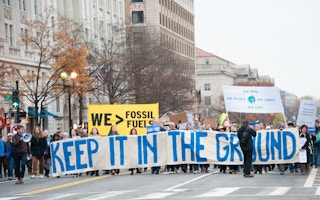The Paris climate agreement is an extraordinary achievement. It codifies the long-term goal of keeping global temperature increases below 2°C. It also sets a more ambitious aspirational target of capping global warming at 1.5°C degrees.
But this more ambitious target will be beyond our reach within a decade or two at current rates of fossil fuel use around the world.
Beyond how achievable the goals are, and at what cost they can be achieved, they are aggressive and consistent with minimising the dangerous interference of human activities on the climate system.
The Paris agreement also recognises the significant gap between the actions needed to stabilise global temperatures and the current national mitigation pledges through 2030. As written now, those pledges won’t keep average temperatures below 2°C, let alone 1.5°C. That’s why the document encourages nations to strengthen their targets in the near future.
The agreement focuses not just on mitigation activities, but on adaptation, too. Adaptation includes the many activities that reduce the costs and consequences of climate change that will occur even after mitigation.
The Paris agreement calls for substantial efforts to develop new capabilities for adaptation and the funding needed to support them. Even climate stabilisation below 2°C will, and has already begun to, bring climate impacts, particularly to the most vulnerable nations and communities.
And, as always, under the Framework Convention on Climate Change, the document acknowledges the dangers of looking at the world through the single lens of climate change. We need to safeguard other critical services such as food production, water resources, and biodiversity.
Some shortfalls
The agreement missed the opportunity to establish some mid-term goals, sharpening the milestones required after 2030. We know that the current mitigation pledges to 2030 are not enough to keep global temperatures below 2°C. The hard work of mid-term goals lies ahead of us.
A specific emissions mitigation target for 2050, for instance, would have benchmarked where emissions need to be to keep temperatures below 2°C by end of this century. Intermediate goals are critical for keeping us on track with compatible pathways.
Instead, the agreement settled on the goal of achieving a balance between sources and sinks of greenhouse gases during the second half of this century. This goal is based on the results of the last assessment report of the Intergovernmental Panel on Climate Change.
The “balance” acknowledges that we could still have some greenhouse gas emissions in the future but these emissions would need to be offset by the removal of an equivalent amount of greenhouse gases from the atmosphere. We interpret this language as being the same as the better known requirement of “zero net emissions”.
“
This more ambitious target will be beyond our reach within a decade or two at current rates of fossil fuel use around the world.
An important shortcoming of calling for achieving a greenhouse gas balance “in the second half of the century” is that it leaves open the possibility that the balance might not be achieved until 2100. This more lenient approach would almost certainly fail to keep global temperatures under 2°C.
An additional shortcoming concerns the contentious issue of financial payments and incentives. The agreement recognises the fact that nations, mostly developing, representing almost half of all greenhouse gas emissions don’t yet have a plan to peak (initially) and then reduce their emissions unless climate financing is available. The text of the agreement is vague and does not clarify how such funds will be obtained, distributed, and monitored.
Let’s get to work
To enter into force, the Agreement will need to be ratified by at least 55 nations under the UN climate convention. These parties must also be responsible for at least 55 per cent of total global greenhouse gas emissions.
It took years for the Kyoto Protocol to be ratified, so it is important this agreement be ratified quickly. The longer this is delayed, the faster countries will have to reduce emissions.
The “55 per cent of emissions” number is an interesting one. Two countries, China and the United States, are responsible for 44.5 per cent of global carbon dioxide emissions. It is technically possible therefore for the agreement to enter into force if all countries except the US and China ratify the deal, but that outcome seems unlikely.
Ratification in China will hinge on its perceived effects on economic development.
Approval in the US will largely depend on a legal determination of whether the agreement must be ratified by the senate. This was a major reason the US has not ratified the Kyoto Protocol.
Even if 55 countries representing 55 per cent of global emissions ratify the agreement, it will do little to achieve the goal of limiting warming to 2°C. Unless countries covering more than 90 per cent of global emissions ratify the agreement, there is little chance of success in reaching the ambitious climate goals.
The need for immediate action includes raising at least US$100 billion per year by 2020. This challenge is enormous, but necessary, if developing countries are to forego the fossil-fuel-intensive development that characterised wealthier nations in the past.
And finally, we need to build new capacity for climate adaption, particularly in poorer, more vulnerable nations. Climate change is already here, and its fingerprint in many recent climate extremes is clear. All countries and communities need new capacity and knowledge to strengthen their resilience and sustainable development pathways.
![]()
Pep Canadell is CSIRO scientist, and executive director of Global Carbon Project, CSIRO and Rob Jackson is professor, Earth System Science, Stanford University. This article was originally published on The Conversation.









